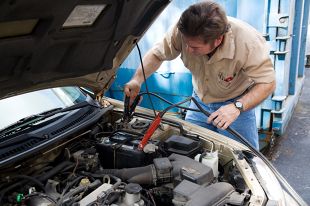
Energy management
 The growing demand for electricity, associated with an increase in the number of electrical equipment, has forced the need for an electrical energy management system in cars, so as not to lead to a situation where it may not be available until the engine is started. restarted.
The growing demand for electricity, associated with an increase in the number of electrical equipment, has forced the need for an electrical energy management system in cars, so as not to lead to a situation where it may not be available until the engine is started. restarted.
The main tasks of this system are monitoring the state of charge of the batteries and regulating the receivers via the bus.  communication, reducing power consumption and obtaining the currently optimal charging voltage. All this in order to avoid too deep discharge of the battery and to ensure that the engine can be started at any time.
communication, reducing power consumption and obtaining the currently optimal charging voltage. All this in order to avoid too deep discharge of the battery and to ensure that the engine can be started at any time.
Various so-called action modules. The first is responsible for battery diagnostics and is always active. The second controls the quiescent current, turning off the receivers when the car is parked, with the engine off. The third, the dynamic control module, is responsible for regulating the charging voltage and reducing the number of consumers turned on when the engine is running.
During continuous battery evaluation, the computer monitors battery temperature, voltage, current, and operating time. These parameters determine the instantaneous starting power and the current state of charge. These are the core values for energy management. The charge status of the battery can be displayed on the instrument cluster or on the multifunction display screen.
When the vehicle is stationary, the engine is off and various receivers are on at the same time, the energy management system ensures that the idle current is low enough so that the engine can be started even after a long time. If the battery shows too low charge, the computer starts turning off active receivers. This is done according to a programmed shutdown order, usually divided into several stages depending on the state of charge of the battery.
At the moment the engine is started, the dynamic energy management system begins to work, the task of which is to distribute the generated electricity to individual systems as needed and receive a charging current corresponding to the battery. This happens, among other things, by adjusting powerful loads and dynamic adjustment of the generator. For example, during acceleration, the engine control computer will request energy management to reduce the load. Then the energy management system will first limit the activity of large loads, and then the power that the alternator produces during this time. On the other hand, in a situation where the driver turns on high-power consumers, the generator voltage is not immediately brought to the required level, but smoothly over a period specified by the control program to obtain a uniform load on the engine.
